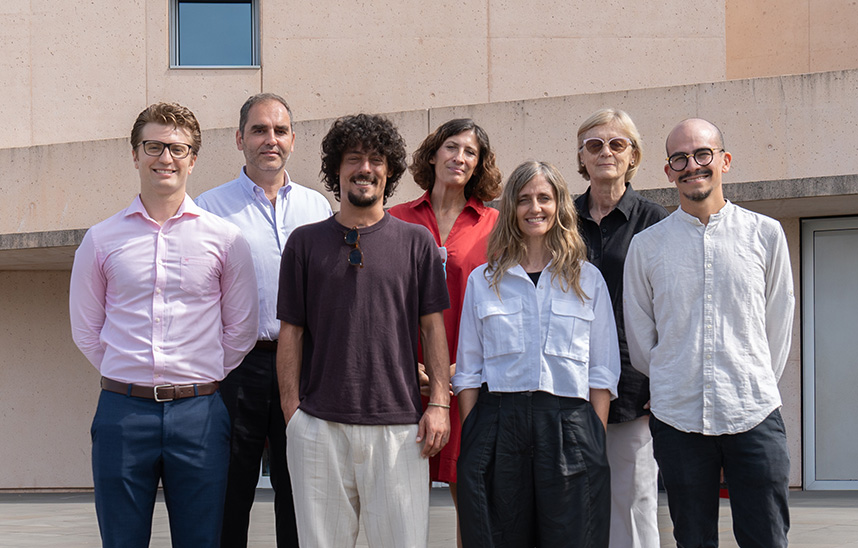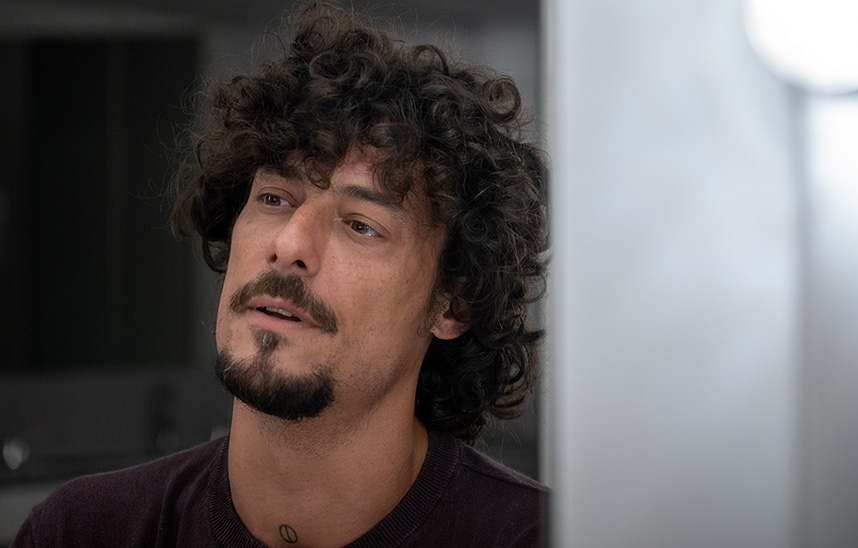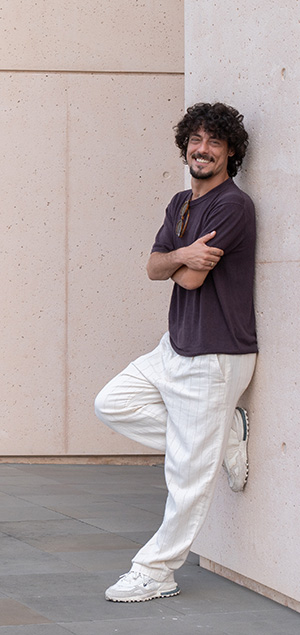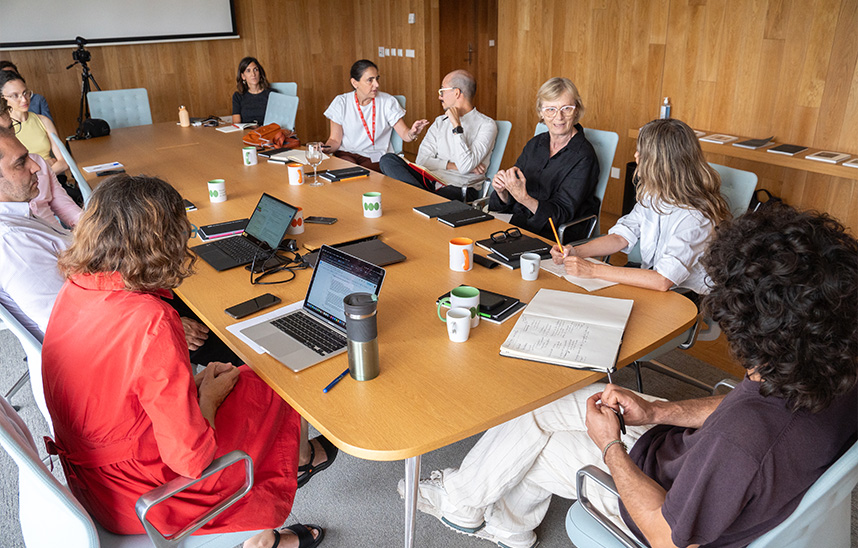Jesús Carmona and the Museo Universidad de Navarra: when art dances with research
The dancer has met with a group of experts from the University, the Clinic and the Cima University of Navarra to work on his next show, which reflects on mental health.

PhotoRaúlVillegas/Jesús Carmona with María Cabeza de Vaca, Teresa Lasheras and researchers from the University and the Clinic.
Mental health is gradually ceasing to be a taboo in our conversations, in the news or in fiction. The field of research and the artistic world have a lot to tell us, and to tell each other, about it.
The best dancer in the world (Benois de la Danse Award 2021), Jesús Carmona, participated in a working session at the MUN with five researchers from the University, the Clinic and the Cima University of Navarra. He did so to talk, among other things, about dissociative identity disorder, the starting point of the premiere that he will present on September 26. It is Súper viviente, a show that reflects on mental health, co-produced by the MUN and the Jesús Carmona Company, with the support of the Community of Madrid. The artist shares stage direction with María Cabeza de Vaca. Tickets for the show are on sale at the box office and on the web.
Psychiatrist Enrique Aubá and psychologist Francesco de Lorenzi, from the Clínica Universidad de Navarra (CUN); Carmen Urpí, dedicated to artistic education, and Luis Humberto Eudave, to psychology, at the School of Education and Psychology of the University of Navarra; and María Asunción Pastor, who has focused on neurology at CIMA, are the professionals who have contributed their points of view to the dancer.
"As time goes by, we need more accurate answers, more visions, more opinions to generate our own," explains Carmona about his interest in sitting down with them. While with El salto he wondered about his masculinity, and in Baile de bestias about his inner beasts, Carmona now completes a trilogy of self-knowledge. With Súper viviente, he intends to find out who he is.

Carmona returns to MUN with a world premiere (©Raúl Villegas)
But how did this synergy come about? The Director of Performing Arts and Music, Teresa Lasheras, says that "the mission of the MUN is to transform people through art". This purpose meets the interest of the University and the Clínica Universidad de Navarra in mental health, a field in which they are leaders. In addition, there is the simplicity "with which the MUN facilitates collaboration between academic and artistic research," Lasheras continues. We have it in our house, which is something absolutely unique in the artistic panorama". "They believed in this project from the very first moment. They helped me and gave me all their possibilities to do it," Carmona adds. And he underlines: "They have opened their doors to accompany us without hesitation".
"It is a dialogue so that each one, from his or her discipline, can nuance and contrast this creation," says Dr. Enrique Aubá, a psychiatrist. As for the specific contribution of his specialty, he indicates that a large part of psychopathology has to do "with the awareness of the self and the awareness of one's own body". He also stresses the importance of reflection on identity, a key element in artistic interpretation, as the ability to embody "another identity, another personality".
For his part, Luis Humberto Eudave, from the Faculty of Education and Psychology, emphasizes that studying dissociative disorders through cognitive neuroscience helps to understand "how the usual alterations of these patients in emotional processing, memory or attention are related to changes in brain functioning". These alterations, he argues, "can be translated and manifested through Jesús Carmona's show".
Carmen Urpí (art education) agrees, highlighting how a "co-creative" proposal of this type can "bring the issue of mental health closer to the general public". In fact, CUN psychologist Francesco de Lorenzi values his participation in this initiative as "the opportunity to see how clinical and psychological language can be translated into artistic expression, and how the public can be led to a more empathetic and visceral understanding of these disorders".
"I see in this project a unique opportunity to unite psychology and art in an effort to destigmatize mental disorders," de Lorenzi continues. And he values the power that art has to touch people "in a way that psychiatry or traditional psychology cannot always do," so he takes the opportunity to "explore new ways to communicate and humanize the experiences related to these disorders."

(©Raúl Villegas)
María Asunción Pastor, from the Cima University of Navarra, makes her contribution from neuroscience, thanks to research in motor control and learning. "At Cima we have always been interested in seeing brain plasticity with learning, by means of functional magnetic resonance techniques, even during aging. Jesús Carmona considers how the physical impairments of aging, for example, affect the psyche. How they affect our personality, which adapts or transforms with the relationship between different societies and social groups. What weight does one's own personality or the group have," he explains. And he believes that this MUN initiative has "enormous appeal" by offering "a practical interdisciplinary dialogue between artists and researchers from various fields in the humanities and sciences on an original dance work that is being developed".
The relationship between Carmona and MUN, however, is not new. Already in 2021 the dancer got on its stage with Baile de bestias, moment from which, tells the artist, the relationship has been very good and, in fact, he expects it to "keep growing". "The human side is what I would highlight the most. That made Baile de bestias a success," he confesses. In addition, the university context presents itself as an ideal environment for an artist, interested in young audiences, and looking for an exploration of new aesthetics and artistic forms within flamenco.

A moment of the working session (©Raúl Villegas)
Súper viviente is part of the VII edition of the Museo en Danza. Another of the great figures included in this program is the new director of the National Dance Company, Muriel Romero (Stocos Institute) with the premiere of Incubatio. Until August 31 there is a 15% discount for advance sales for all proposals. In addition, a season ticket can be purchased for Súper viviente, La argentina en París ( Antonio Najarro Company) and Go Figure (Sharon Fridman Company).
Museo en Danza positions the MUN as a center of reference for contemporary dance, including newly created works, thanks to synergies of this type and artistic residencies that enhance communication between artists, researchers from different fields and the university community.
"Súper viviente" is supported by members of the sponsoring board of trustees.
The Museo en Danza cycle is carried out in collaboration with INAEM, the Government of Navarra and the City Council of Pamplona. The shows QTA and Luz negra are also part of DNA - Festival de Danza Contemporánea de Navarra.